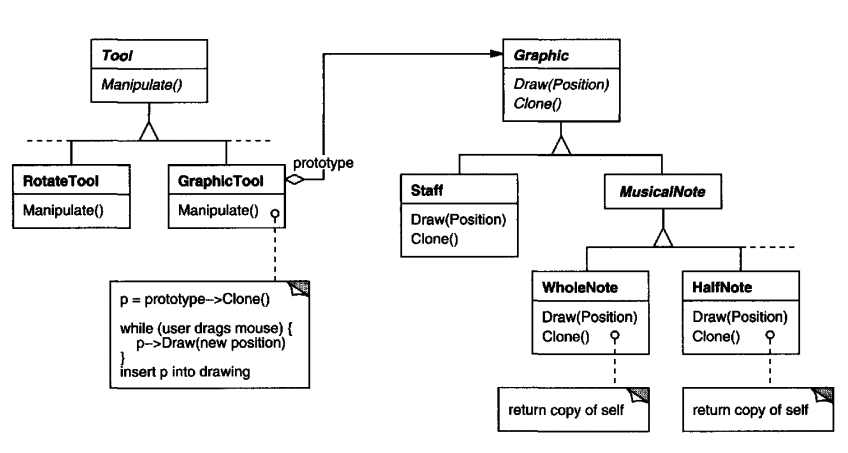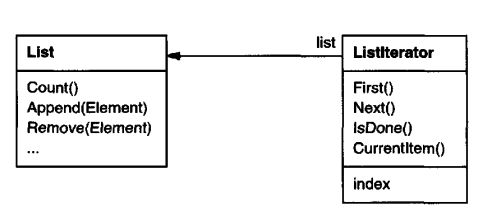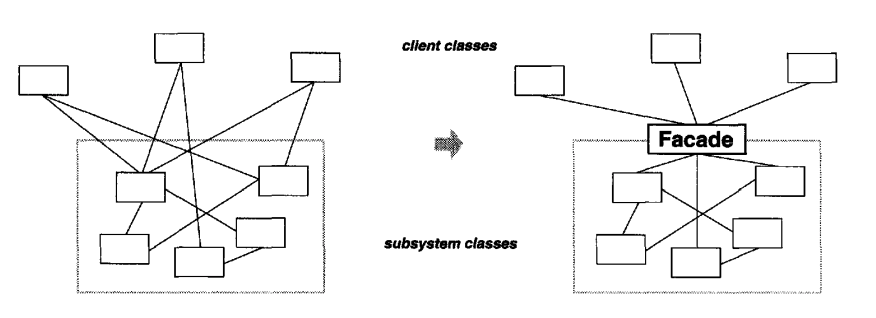Prototype
Intent
Define a prototypical object instance which you can copy.
Motivation
A music editor has functionality to create various music elements (e.g. notes, staves) & add them on the screen to create a music composition.
There’s a class called GraphicTool which allows one to drag-n-drop new graphic elements on the screen.
Problem - how can the GraphicTool instantiate user-defined types & manipulate them on the screen, given that GraphicTool is part of a framework?
Answer - create a common interface with a clone() function which allows GraphicTool to copy prototypical instances of your user-defined types & manipulate them via a common interface.

An added benefit is that using prototypes you can avoid creating too many subclasses because when subclasses are effectively different configurations of a given class, you can just create different prototypes representing the different configurations.
Applicability
Use Prototype when the system should be independent of how its products are created & represented. Also:
- when the classes have to instantiated dynamically at runtime.
- to avoid building a factory class hierarchy which mimics the class hierarchy of products.
- when instances of a class can have one of only a bunch of possible configurations.
Structure

Participants
- Prototype (Graphic) - declares an interface for
clone - ConcretePrototype (Staff, WholeNote, HalfNote) - concrete implementation that can
cloneitself - Client (GraphicTool) - creates new objects by asking a prototype to clone itself
Consequences
Prototype shares many of the consequences of Abstract Factory and Builder - clients need not know about the concrete products they’re creating.
Added benefits:
- Products can be added and removed at runtime
- Specifying new objects by varying values - instead of subclassing to change an object’s configuration, you can create different prototypes of the same class
- Specifying new objects by varying structure - you can clone an entire hierarchy of objects, defined as a prototype. E.g. a composite structure can be copied, reused & extended when defined as a prototype.
- Reduced subclassing - Factory Method often produces a hierarchy of
Creatorclasses, which parallels the products hierarchy. With Prototype, this can be avoided.
Main drawback:
- Each subclass needs to implement
clonewhich might be difficult for certain kinds of objects - eg ones with circular dependencies.
Implementation
- Using a prototype manager - if the # of prototypes in a system is dynamic, you can keep a registry of available prototypes.
- Implementing
clone- you need to differentiate between shallow & deep copying. A hack for implementingcloneis to serialize & deserialize an object if it supports it. - Initializing clones -
clonedoesn’t support adding any parameters to eg initialize a prototype’s internal state. Therefore, you might have to supplement prototypes with aninitializefunction or additional setters.
Sample Code
We’ll define a MazePrototypeFactory which has factory methods for creating maze objects by leveraging the prototype pattern:
public class MazePrototypeFactory extends MazeFactory {
private final Maze mazeProto;
private final Wall wallProto;
private final Room roomProto;
private final Door doorProto;
public MazePrototypeFactory(Maze m, Wall w, Room r, Door d) {
this.mazeProto = m;
this.wallProto = w;
this.roomProto = r;
this.doorProto = d;
}
@Override
public Maze makeMaze() {
return mazeProto.clone();
}
@Override
public Wall makeWall() {
return wallProto.clone();
}
@Override
public Room makeRoom() {
return roomProto.clone();
}
@Override
public Door makeDoor(Room r1, Room r2) {
Door d = doorProto.clone();
d.initialize(r1, r2);
return d;
}
}
To create a standard maze:
MazePrototypeFactory f = new MazePrototypeFactory(new Maze(), new Wall(), new Room(), new Door());
Maze m = game.createMaze(f);
To create a bombed maze:
MazePrototypeFactory f = new MazePrototypeFactory(new Maze(), new BombedWall(), new RoomWithABomb(), new Door());
Maze m = game.createMaze(f);
Related Patterns
Prototype and Abstract Factory are competing patterns, but they can also be used together. An abstract factory might store a set of prototypes from which objects are initialized.
Designs that make use of Decorator and Composite can also benefit from Prototype.
 04.Iterator - example-list-iterator
04.Iterator - example-list-iterator